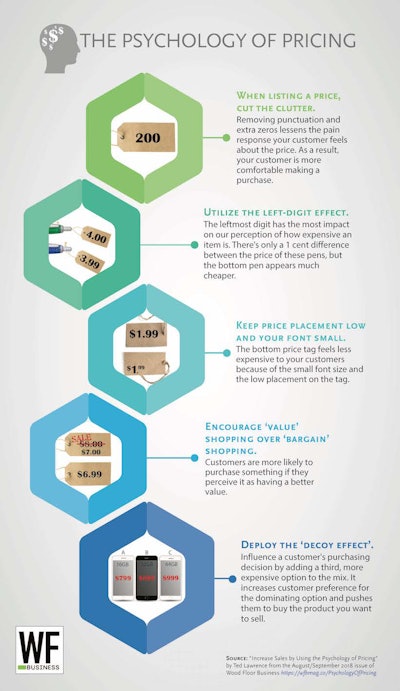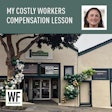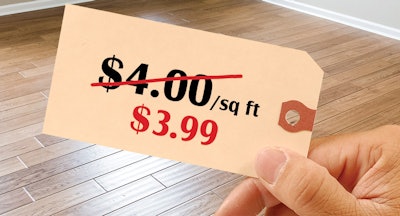
Growing up around the grocery industry, there was one retail concept I found particularly interesting: how to create a pricing strategy that can influence what a customer buys. This is called "the psychology of pricing," and it all starts with understanding how our brain rationalizes the decision to purchase something.
To do that, we have to look back to our caveman days, when we were hunters and gatherers whose survival depended on acquiring and accumulating basic resources such as food, water and shelter. As we evolved, we started trading and began using a monetary system. Spending money became a means of acquiring those basic essentials for survival, just like hunting and gathering—and our brain doesn't recognize the difference. We continue to rationalize spending money by using the same part of the brain the hunters and gatherers used. So in essence, spending money is experienced in the same part of the brain as feeling physical pain!
Because of this, not every consumer is rational when it comes to pricing. Here are six guidelines showing how that lack of rationality can have a huge positive impact on your sales:
1. When listing a price, cut the clutter
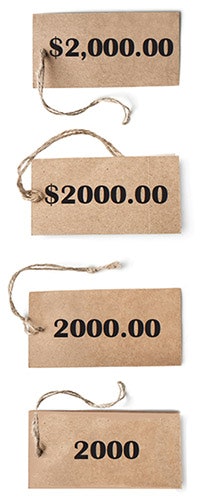 Removing punctuation and extra zeros lessens the pain response your customer feels about the price. As a result, your customer is more comfortable making a purchase.
Removing punctuation and extra zeros lessens the pain response your customer feels about the price. As a result, your customer is more comfortable making a purchase.
Researchers at Cornell University created an experiment at St. Andrew's Café, part of the Culinary Institute of America in Hyde Park, N.Y. They offered three types of menus:
1. One had the price listed with a dollar sign in front of the numerals.
2. One listed the price without a dollar sign.
3. The third had the price followed by the word "dollar," spelled out.
The results were interesting—when prices were listed with a dollar sign ($5.00), customers spent less. When the dollar sign was absent (5.00), they tended to spend more. Spelling out the word "dollar" triggered what is called a "pain of paying response."
Removing the currency symbol ($) lessens the pain associated with the number, which is why you often see restaurants omitting the currency symbol from their menus.
When merchandising new products in your store, try removing all the dollar signs you can. If you can't, try making it as small as possible to reduce the pain of paying response.
While you're at it, you might want to consider removing punctuation (decimal points and commas in particular) and excessive zeros. To see why, take a look the numbers at left — which looks the most expensive?
2. Utilize the left-digit effect
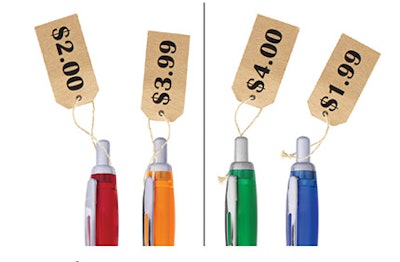 The leftmost digit has the most impact on our perception of how expensive an item is. Which would you choose in each pair above?
The leftmost digit has the most impact on our perception of how expensive an item is. Which would you choose in each pair above?
Many of you might already use a "charm pricing" strategy (prices that end in ".99" or ".95") in your store, but do you know how it works? The leftmost digit disproportionately affects our perception of price. Our brains encode numbers so quickly (and subconsciously) that we encode the size of a number before we finish reading it.
For example, the "2" in $2.99 exerts more influence on our perception of price than the ".99." So shaving the price of something is most effective when it changes the leftmost digit (in this case from a 3 to a 2).
A study in 2009 titled "Price Endings, Left-Digit Effects, and Choice" asked participants to consider two pens, one priced at $2.00 and the other at $4.00. A penny decrease in the price of either pen lowered the price's leftmost digit.
The researcher manipulated the prices and found that when the pens were priced $2.00 and $3.99, 44 percent of the participants selected the higher-priced pen.
But when the pens were priced $1.99 and $4.00, only 18 percent of the participants chose the higher-priced pen.
The larger perceived price difference between the pens priced at $1.99 and $4.00 led people to focus on how much they were spending and ultimately resulted in a strong tendency to select the cheaper alternative.
3. Use prices with fewer syllables
Do you think a price seems more expensive if it has more syllables? Probably not, but research says it does. When you read a price in written form, your brain subconsciously encodes the auditory version of that price:
$27.82 (seven syllables)
$28.16 (five syllables)
When we read a price tag, our brain immediately encodes the value and determines that the price with more syllables seems more expensive. So keep in mind the syllable count when you are setting pricing of anything in your store. Even for lower-cost items, syllable counts can make a big difference!
4. Keep price placement low and your font small
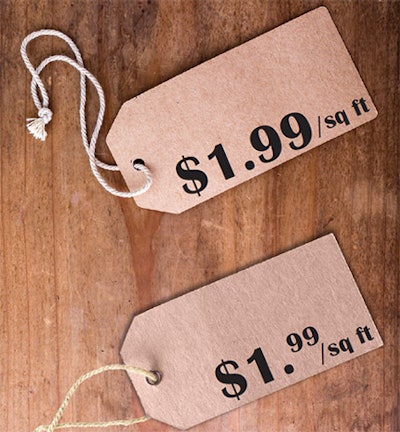 The bottom price tag feels less expensive to your customers because of the small font size for the 99 cents.
The bottom price tag feels less expensive to your customers because of the small font size for the 99 cents.
Can the position of a price on a sign and its font size really affect the way our brain encodes the number? Absolutely. Every store we visit, from grocery stores and mass merchants to specialty retailers like wood flooring stores, has trained us that items placed higher on a shelf are more expensive—that's why some alcohol is described as "top shelf." So when we see a price at the top of a sign first, our brain perceives it as a more expensive item.
The solution is to not only put the price at the bottom of the sign, but also make the font as small as possible and tuck it into either the left or right side of the sign. This makes the price seem small and insignificant and thus lower.
Consider reducing the size of the font on right-hand digits as well.
5. Encourage 'value' shopping over 'bargain' shopping
 Customers are more likely to purchase somthing if they perceive it as having a better value.
Customers are more likely to purchase somthing if they perceive it as having a better value.
I cannot preach the meaning of value enough, and I think many of the stores I visit truly don't understand how creating value has an even bigger impact in a referral-based business than it does during the initial purchase. Our goal is to turn consumers from "bargain hunters" into "value seekers." We all love a bargain, but value trumps bargain almost 100 percent of the time.
Economist Richard Thaler from the University of Chicago conducted a value experiment, pricing two identical items in a different way. The first was labeled on sale for $40, regularly $48. The second item was simply charm priced at $39.
Consumers overwhelmingly purchased the $40 item—even though there was a less expensive option—because it was perceived as higher quality and a better value, even though they were identical!
You can also sell value by "price anchoring" an item. In other words, place ultra-premium products and services near more standard options. This creates a clearer sense of value for potential customers, who will view the less expensive options as a bargain in comparison.
6. Deploy the 'decoy effect'
The decoy effect (or the "asymmetric dominance" effect) is one of the most classic pricing strategies you'll find. It's a way to influence a customer's purchasing decision by adding a third option to the mix. Apple is a master at it—if you've ever bought an iPhone or an iPad, you're familiar with the decoy effect. Here's how it works:
When you're thinking about buying a new iPhone, you're generally debating the price versus the storage capacity. It's one thing when you're choosing between two items, but Apple offers three storage sizes, each at a different rate.
Option A might not have enough space for you. Option B seems like a good fit until you look at the price tags. This is when your brain starts to rationalize buying the top-tier model. Though it's the most expensive option, you can get twice the storage for just $100 more. What a deal!
That's the power of the decoy effect: It increases customer preference for the dominating option and pushes you to buy the product Apple really wants to sell.
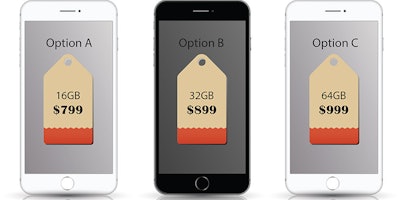 A close look at the decoy effect. Which phone would you choose?
A close look at the decoy effect. Which phone would you choose?
These are just a few of the many ways the psychology of pricing can help you sell more without working more. Take some time to think about your pricing and product selection and analyze what is and is not selling. Often, you can trace a product's success to how it was priced in comparison with other products in the store or if you are, in fact, creating value for the customer.
